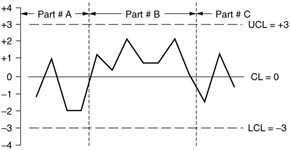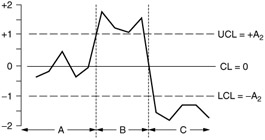INTERPRETATION OF SHORT-RUN CHARTS
INTERPRETATION OF SHORT-RUN CHARTS
The interpretation of short-run charts is similar to that for traditional Shewhart charts. For variable-data charts, the range (or sample standard deviation) portion of the chart should always be interpreted first, then the Xbar portion.
OUT-OF-CONTROL CONDITIONS
Just as for traditional charts, a single point outside a control limit signals a significant sudden change in that process parameter. A run of seven or more consecutive points on one side of a chart's center line indicates the presence of a sustained shift in that process parameter.
A downward (or upward) trend consists of six or more points moving consecutively downward (or upward). This pattern reveals the presence of an assignable source of variation that is slowly changing the charted process parameter. A repeating pattern of plot points is known as a cycle. Cycles imply that a regularly recurring assignable source of variation is acting on the process.
INTERPRETATION FOR PROCESS CONTROL
The major difference with interpreting short-run charts is that it is done twice; once for process control and a second time for part number control. The interpretation for process control is done by looking at all the process output data, regardless of part number. This is done to detect any time- related changes associated with the process (machine, manpower, work method, material, measurement system). The assignable sources of variation associated with these out-of-control conditions would be common to all part numbers .
Figure 13.3 shows an upward trend in the number of nonconformities that began with Part Number A and continued while Part Numbers B and C were run. The assignable source of variation causing this out-of-control condition is most likely common to all three part numbers (gage drift , plugged coolant line, operator fatigue, loosening of a fixture). It acts on the process independently of the part number that is being run.

Figure 13.3: A short-run c chart (trend).
INTERPRETATION FOR PART NUMBER CONTROL
The interpretation for part number control involves looking at the plot points for each part number individually to detect the presence of any out-of-control conditions that are unique to that part number. This is why the vertical lines are drawn between the plot points of different part numbers on all the short-run charts. They help to segregate information concerning the performance and interpretation of each part number.
Figure 13.4 shows that the run above the center line of this short-run c chart occurred only during the time that Part Number B was being run. The assignable source of variation responsible for this out-of-control condition is most likely associated with only Part Number B (special fixturing for B, different tool used just for B, B is machined from a different type of material).

Figure 13.4: A short-run c chart (run).
INTERPRETATION OF SHORT-RUN R (OR S) CHART
If the actual process variation (as measured by the subgroup range, R) is in fact equal to, or very near, the expected process variation (target Rbar), then the ratio of R to target Rbar is equal to 1, and the plot point falls on the center line of the short-run R chart (Section A of the short-run R chart shown in Figure 13.5).

Figure 13.5: A short-run R chart.
If a point falls on the center line of a chart, it is very unlikely that the operator will make an adjustment to the process. Therefore, when the expected amount of process variation is actually being generated, the operator leaves the process alone.
Suppose that the actual process variation increases significantly. The subgroup ranges are now larger than expected, so the ratio of R to target Rbar will be much greater than 1. If this ratio exceeds the upper control limit, the operator has a signal to initiate corrective action (as shown in Section B on Figure 13.5).
If the process variation decreases significantly, the subgroup ranges are smaller than expected, and the ratio of R to target Rbar is now less than 1. If this continues for an extended period of time (seven or more consecutive plot points), the operator is alerted to an improvement in the process (as shown in Section C on Figure 13.5).
INTERPRETATION OF SHORT-RUN XBAR CHART
If the actual process average (as measured by the subgroup average, Xbar) is equal to the expected process average (target Xdouble bar), then the ratio below is equal to 0 (because Xbar - target Xdouble bar = 0), and the plot point falls on the center line of the short-run Xbar chart.
When the process is centered as expected, the operator leaves the process alone (as shown in Section A of Figure 13.6)

Figure 13.6: Short-run Xbar.
Suppose that the actual process average significantly increases. The individual measurements are now all larger than before. Subgroup averages of these individuals are now larger than expected, so the difference of Xbar - target Xdouble bar will be positive (greater than 0). This means the Xbar plot point is also greater than 0. If it exceeds the upper control limit, this is a signal for the operator to initiate corrective action (see Section B on Figure 13.6).
If the process average significantly decreases, the individual measurements will be smaller than expected and therefore, the subgroup averages will be smaller also. The difference of Xbar - target Xdouble bar is now negative (less than 0), causing the Xbar plot point to be less than 0. If the plot point falls below the lower control limit, the operator has a signal to initiate corrective action (see Section C on Figure 13.6).
INTERPRETATION OF SHORT-RUN ATTRIBUTE CHART
The interpretation is similar to that for the short-run Xbar chart. If the process is generating the expected number of nonconformities (or nonconforming units), then the plot point is 0, and the point falls on the center line of the chart (Section A on Figure 13.7).

Figure 13.7: Short-run attribute chart.

If the actual number of nonconformities (or nonconforming units) in the process increases significantly compared with the target value, the plot point is positive. Any points falling above the upper control limit alert the operator that there has been a deterioration in process quality and that immediate corrective action is necessary (as shown in Section B of Figure 13.7).
If the actual number of nonconformities (or nonconforming units) in the process decreases significantly compared with the expectations, the attribute plot point will be negative. A point falling below the lower control limit (or a run of seven or more below the center line) indicates that an improvement in process quality has occurred. Investigative action should be initiated at once to discover why this positive change has occurred so that the cause may be incorporated as a permanent part of the process (Section C of Figure 13.7).
EAN: 2147483647
Pages: 181